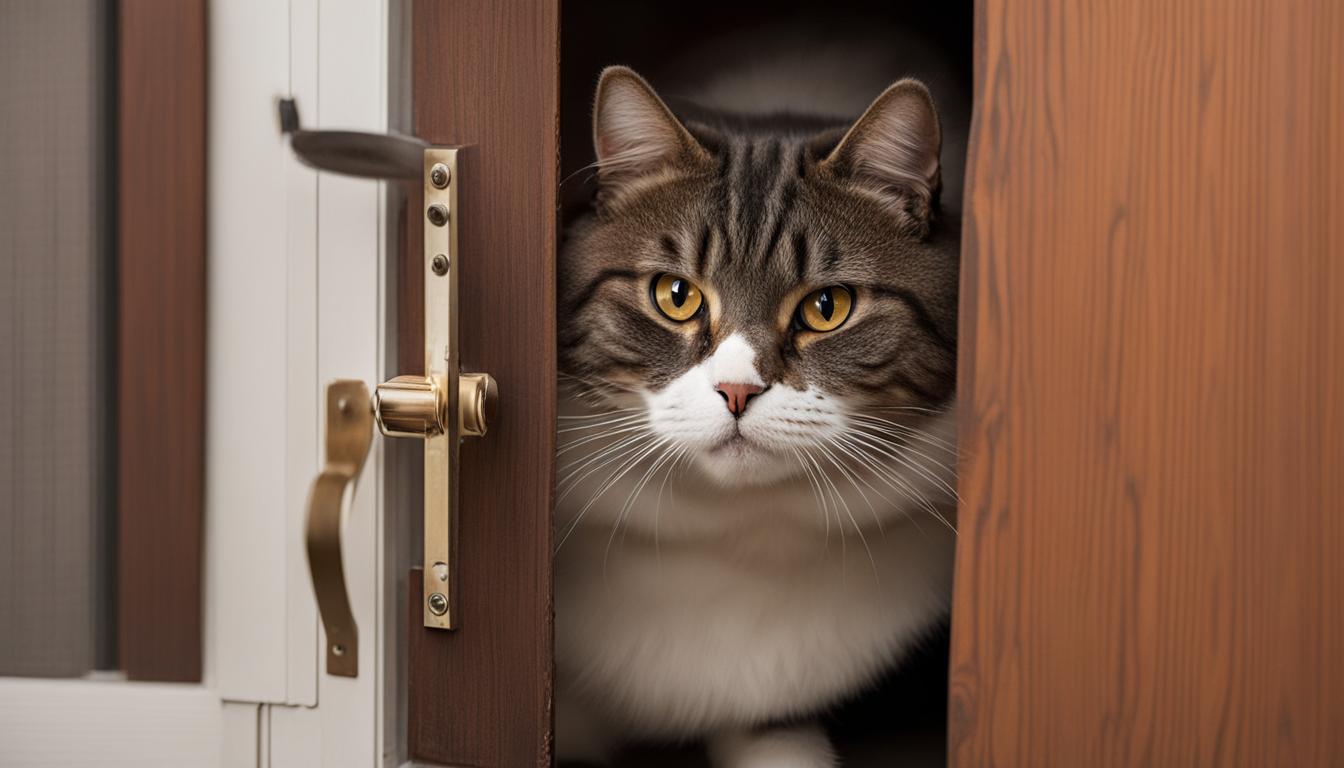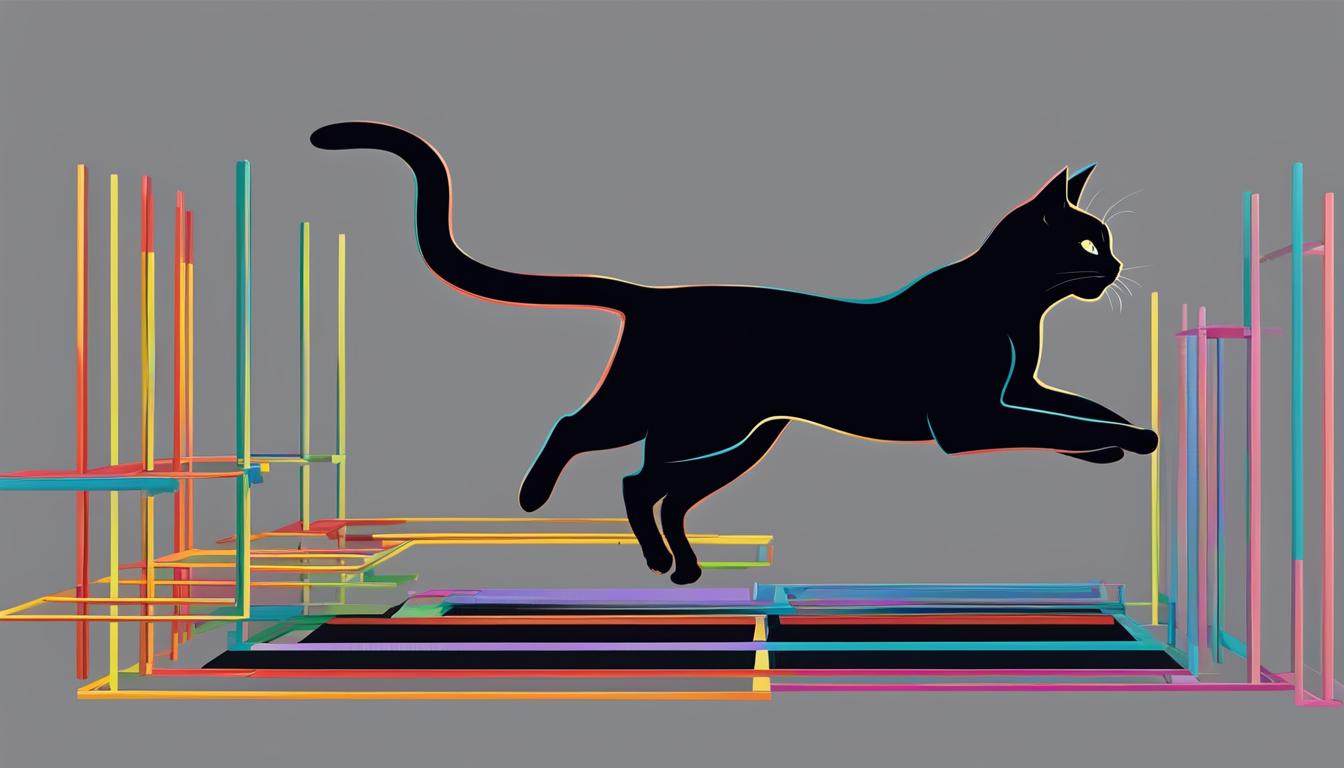Greetings, fellow feline enthusiasts! Today, I invite you on a captivating journey into the world of cat obesity. Have you ever wondered about the impacts of those extra pounds on our beloved furballs? Join me as we delve into the depths of this weighty issue and uncover the secrets to helping our cats achieve a healthier, happier life.
North America is no stranger to the battle against obesity, and our feline friends are not exempt from this epidemic. In fact, nearly 60% of domestic cats in the region are overweight. But what does it really mean for a cat to be obese? Well, it’s not just about the numbers on the scale, my friends. Obesity is defined as an accumulation of excess body fat, and it can have a profound impact on a cat’s health and well-being.
Obesity in cats puts them at a higher risk for a range of diseases, including cancer, diabetes mellitus, heart disease, hypertension, osteoarthritis, urinary bladder stones, and anesthetic complications. It doesn’t stop there – obese cats may also face challenges like hepatic lipidosis, skin and coat problems, and difficulties in fighting infectious diseases. What a heavy burden to bear!
But fret not! There’s a glimmer of hope amidst the fluff. By treating obesity as a chronic, low-level inflammatory condition, we can combat these issues head-on. You see, fat tissue is more than just an extra layer; it’s biologically active and secretes inflammatory hormones that contribute to disease development and decrease quality of life. It’s time to tap into this newfound knowledge and take action to ensure our cats lead their best lives.
Key Takeaways:
- Cat obesity impacts their overall health and increases the risk of various diseases.
- Treating obesity as a chronic, low-level inflammatory condition can lead to better outcomes.
- Obese cats are more susceptible to hepatic lipidosis, skin problems, and difficulties in fighting infections.
- Understanding the biological activity of fat tissue is crucial in combating obesity.
- Let’s embark on this journey together and help our cats shed those extra pounds for a healthier, happier life!
The Health Risks of Feline Obesity
In the battle against feline obesity, understanding the health risks is crucial. Obesity in cats not only impacts their overall well-being but also increases the risk of various diseases and conditions. One of the significant health risks associated with feline obesity is the development of obesity-related diabetes. Research has shown that overweight cats have a higher chance of developing diabetes mellitus, a condition that affects their ability to regulate blood sugar levels and can lead to serious health complications.
Another common health risk for obese cats is joint problems. The excess weight puts additional strain on their joints, leading to increased wear and tear, and a higher likelihood of developing osteoarthritis. This can result in chronic pain and reduced mobility, significantly impacting a cat’s quality of life. Furthermore, obesity exacerbates the inflammatory response in the body, which can contribute to heightened joint inflammation and discomfort.
Being overweight or obese can shorten a cat’s lifespan. Obesity is associated with a 2.8-fold increase in mortality compared to lean cats, even in moderately overweight felines. The health risks of feline obesity extend beyond diabetes and joint problems. Other conditions, such as heart disease, hypertension, urinary bladder stones, anesthetic complications, hepatic lipidosis, and skin and coat problems, are also more prevalent in overweight and obese cats.
By recognizing the health risks of feline obesity, cat owners can take proactive steps to manage and prevent this condition. Through appropriate diet plans, regular exercise, and close monitoring of their cat’s weight, owners can help their feline companions live healthier and happier lives.
Measuring Ideal Weight in Cats
When it comes to determining whether a cat is overweight or obese, measuring their weight in relation to their ideal body weight is an important factor to consider. Cats are considered overweight when they weigh 10-20% above their ideal body weight and obese when they weigh more than 20% above their ideal body weight.
Veterinary health care teams can perform body condition assessments using a scoring system to determine the cat’s ideal body weight and regularly monitor their progress towards achieving a healthy weight. This helps to ensure that weight loss is gradual and sustainable, promoting the long-term well-being of the cat.
Calorie-controlled diets designed for weight reduction are an effective tool in helping cats safely shed excess pounds. Brands such as Hills® Prescription Diet Metabolic, Royal Canin® Satiety Support Weight Management, and Purina Overweight Management® offer specially formulated diets that provide the necessary nutrients while helping to manage calorie intake. It’s important to note that simply reducing the volume of their current food is not suitable and can lead to malnourishment over time.
Table: Popular Calorie-Controlled Diets for Cats
| Brand | Description | Key Features |
|---|---|---|
| Hills® Prescription Diet Metabolic | A clinically proven weight management diet for cats. | Helps cats burn calories and lose weight safely. |
| Royal Canin® Satiety Support Weight Management | A high-protein diet for cats designed to help them feel full and satisfied. | Controls excessive weight gain and supports muscle mass. |
| Purina Overweight Management® | An easily digestible diet that promotes healthy weight loss. | Rich in protein and low in fat to support muscle and promote satiety. |
By accurately measuring a cat’s ideal weight, implementing calorie-controlled diets, and regularly monitoring their progress, cat owners can play an active role in helping their feline companions achieve and maintain a healthy weight.
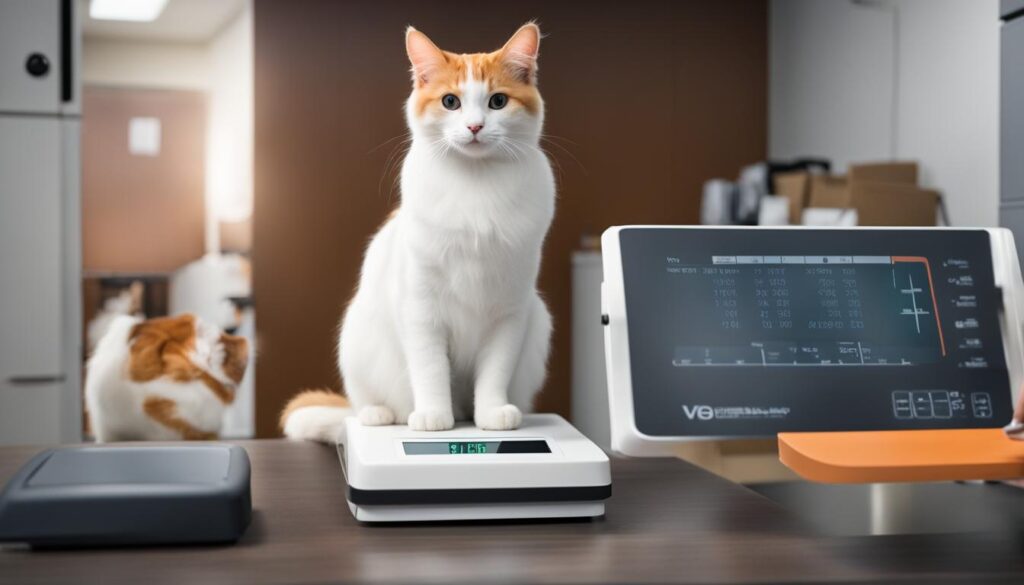
Tips for Feeding and Weight Loss in Cats
Feeding and managing the weight of multiple cats can be a challenge, but with the right strategies, it can be done effectively. Here are some tips to help you navigate feeding and weight loss for your feline companions:
1. Individualized Feeding
Each cat has different nutritional needs, so it’s important to feed them individually. This allows you to control portion sizes and ensure that each cat is getting the appropriate amount of food. Use separate feeding bowls or place cats in different rooms during meal times to prevent any stealing or overeating.
2. Scheduled Meal Times
Establishing a regular feeding schedule can help regulate your cats’ appetite and prevent constant grazing throughout the day. Divide their daily food portion into several small meals and feed them at specific times. This approach encourages healthy eating habits and prevents overconsumption.
3. Slow and Gradual Weight Loss
When it comes to weight loss, slow and gradual is the way to go. Rapid weight loss can have negative effects on a cat’s overall health. Aim for a weight loss rate of 1-2% of their body weight per week. Consult with your veterinarian to determine the appropriate calorie intake and create a weight loss plan tailored to your cat’s needs.
By following these tips, you can ensure a healthy and controlled feeding routine for your cats, ultimately aiding in their weight loss journey. Remember to monitor their progress regularly, adjust portion sizes as needed, and provide plenty of exercise and mental stimulation to keep them active and engaged.
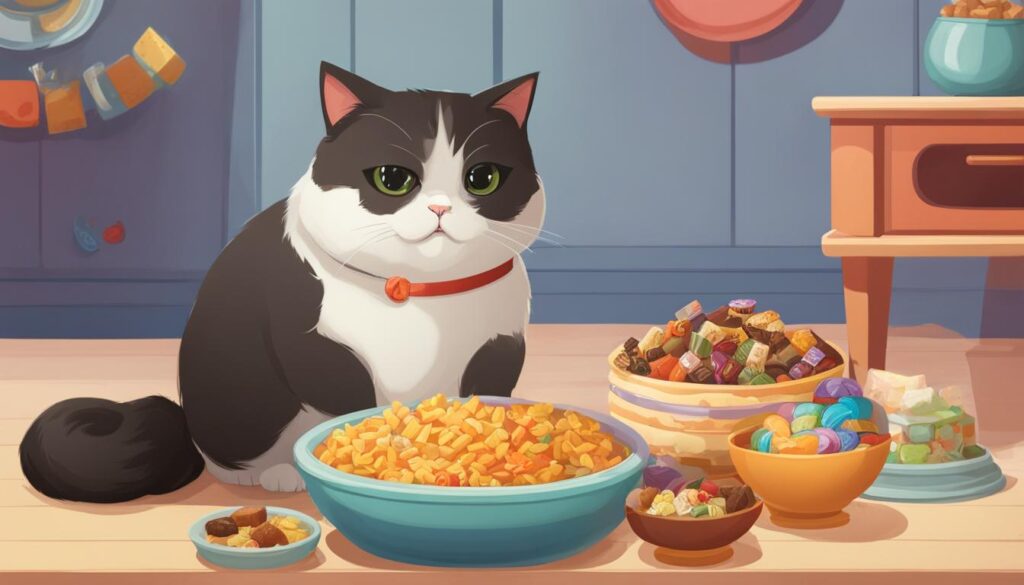
The Impact of Obesity on Pain in Cats
Being overweight or obese can have a detrimental effect on a cat’s health, particularly when it comes to joint problems and pain. The excessive weight puts additional strain on the joints, leading to joint damage and the development of osteoarthritis. This condition causes chronic inflammation and pain in the affected joints, significantly reducing a cat’s quality of life. It’s important for cat owners to recognize the link between obesity and joint problems, as addressing the issue can help alleviate pain and discomfort in their feline companions.
In addition to joint problems, obesity in cats can also contribute to chronic inflammation throughout the body. Fat tissue is biologically active and releases hormones and other chemicals that cause and enhance inflammation. This chronic inflammatory state can lead to increased pain sensitivity and the development of other inflammatory conditions, further complicating a cat’s overall health. By addressing obesity in cats, owners can help reduce inflammation, alleviate pain, and improve their pet’s overall well-being.
Furthermore, obesity has been linked to an increased risk of liver disease in cats. The excess fat accumulation in the liver can lead to a condition known as hepatic lipidosis, which impairs liver function and can be life-threatening if left untreated. By maintaining a healthy weight in cats, owners can reduce the risk of liver disease and promote optimal liver function, ensuring their feline companions stay healthy and happy.
Quote:
“Obesity in cats not only affects their physical appearance but also has a significant impact on their health and well-being. Joint problems and pain can be a major concern for overweight or obese cats, and it’s crucial for owners to address this issue to improve their pets’ quality of life.”
Table: The Link Between Obesity and Joint Problems in Cats
| Impact of Obesity on Joint Problems in Cats | Effects |
|---|---|
| Increased strain on joints | Leads to joint damage and osteoarthritis |
| Chronic inflammation | Enhances pain sensitivity and development of other inflammatory conditions |
| Impaired liver function | Leads to an increased risk of liver disease |
By addressing obesity in cats and implementing strategies for weight loss and management, cat owners can help reduce the risk of joint problems, inflammation, and liver disease. Regular exercise, portion control, and a balanced, calorie-controlled diet tailored to the cat’s specific needs are key components in achieving and maintaining a healthy weight. Consulting with a veterinarian can provide valuable guidance and support in creating a weight loss plan that is safe, effective, and tailored to the individual cat’s needs.
Preventing Obesity in Cats
Preventing obesity in cats is a crucial step in ensuring their overall health and well-being. By implementing a cat weight management program and following a diet plan for overweight cats, cat owners can help their feline companions maintain a healthy weight and reduce the risk of obesity-related health issues.
The Diet Plan
The first step in preventing obesity in cats is choosing an appropriate food that meets their specific nutritional needs. Consult with a veterinarian to determine the best diet plan for your cat. It is recommended to transition to canned food, as it encourages meal feeding and is lower in carbohydrates and higher in protein. Avoid free-feeding and practice portion control by following the recommended feeding guidelines provided by the veterinarian or the cat’s food packaging.
To enhance mealtime engagement and stimulate their natural hunting instincts, consider using interactive feeding toys. This can help slow down their eating pace and prevent overeating. Providing opportunities for exercise, such as play sessions and offering climbing or jumping options, can also help cats burn calories and maintain a healthy weight.
Regular Monitoring
Regular monitoring of a cat’s weight is crucial for maintaining a healthy weight. Use a baby scale at home or visit the veterinarian’s office for weigh-ins every couple of months. This helps detect any weight changes and allows for early intervention if necessary. Annual wellness exams with a veterinarian also provide an opportunity to assess body and muscle condition scores and make any necessary adjustments to the feeding and exercise routines.
| Preventive Measures | Benefits |
|---|---|
| Choosing an appropriate food | Meets specific nutritional needs |
| Practicing portion control | Prevents overeating |
| Using interactive feeding toys | Engages natural hunting instincts |
| Providing opportunities for exercise | Burns calories and maintains a healthy weight |
| Regular monitoring of weight | Detects weight changes and allows for early intervention |
By following these preventive measures and regularly monitoring their cat’s weight, owners can help prevent obesity and promote a healthy weight in their feline companions. Remember, maintaining a healthy weight is crucial for the overall well-being and longevity of cats.
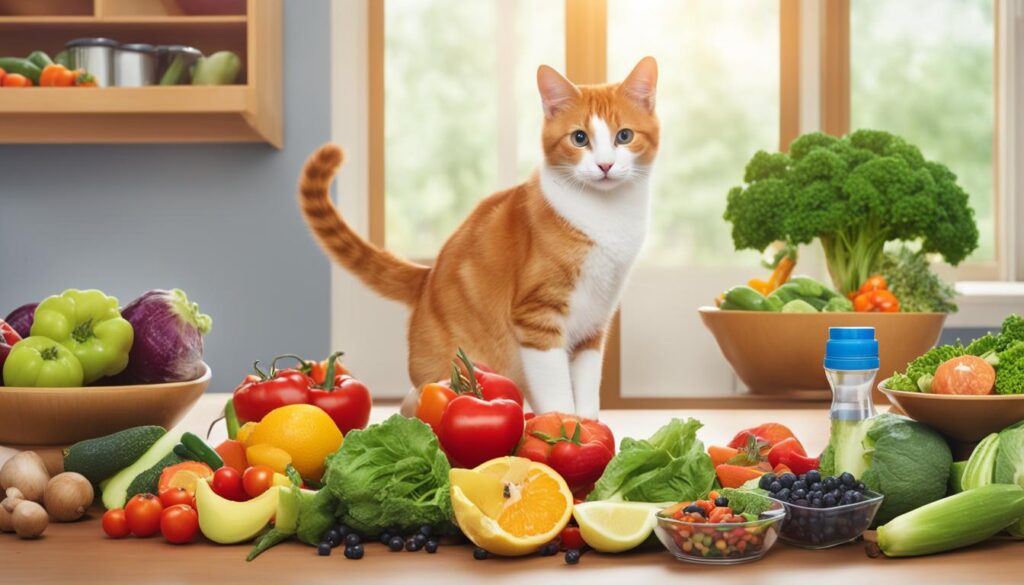
Tips for Feeding Multiple Cats and Measuring Ideal Weight in Cats
Feeding multiple cats can be a challenge, especially when some of them are overweight or obese. Here are some tips to ensure each cat receives the appropriate amount of food:
- Feed cats in separate areas to prevent competition for food.
- Monitor each cat’s eating habits to ensure they finish their meals. If one cat consistently leaves food behind, adjust their portion size accordingly.
- Consider using interactive feeding toys, such as puzzle feeders, to slow down eating and provide mental stimulation.
When it comes to measuring the ideal weight in cats, it’s important to rely on more than just the number on the scale. Here are some additional factors to consider:
- Assess the cat’s body condition score by feeling their ribs and checking for a waistline. A cat at their ideal weight should have a defined waistline and be able to feel their ribs easily.
- Consult with a veterinarian to determine the cat’s ideal weight based on their breed, age, and overall health.
Feeding Multiple Cats: Example Meal Plan
Here’s an example of a meal plan for feeding multiple cats:
| Cat | Portion Size (per meal) | Feeding Frequency |
|---|---|---|
| Cat 1 (Ideal Weight) | 1/3 cup | Twice a day |
| Cat 2 (Overweight) | 1/4 cup | Twice a day |
| Cat 3 (Ideal Weight) | 1/3 cup | Twice a day |
I believe it’s essential to provide each cat with the appropriate amount of food to maintain a healthy weight. By implementing these tips, you can ensure that every cat’s dietary needs are met, and they can enjoy a balanced and fulfilling mealtime experience.
Remember, every cat is unique, and their dietary needs may vary. It’s always best to consult with a veterinarian for personalized advice and guidance.
Next Section: The Impact of Obesity on Pain in Cats
Conclusion
As a cat owner, I understand the importance of maintaining a healthy weight for our feline friends. The impacts of obesity in cats are far-reaching, from increasing the risk of diseases to reducing their lifespan. But fear not, because there are practical tips and strategies that can help your cat achieve a healthy weight and live a happier, longer life.
When it comes to feeding and weight loss, portion control is key. By using appropriate nutritional products and following a scheduled feeding plan, you can ensure that your cat is getting the right amount of food without overindulging. Avoid giving extra snacks or treats, as these can quickly add up in calories and hinder weight loss progress.
Don’t forget about physical activity! Engaging your cat in regular play sessions and providing opportunities for exercise can help them burn calories and maintain a healthy weight. Interactive feeding toys are a great way to combine mealtime with exercise, stimulating their natural hunting instincts and keeping them active.
In conclusion, by implementing proper feeding strategies, encouraging exercise, and closely monitoring their weight, you can prevent obesity and its associated risks in your cat. Remember, regular veterinary check-ups are essential for detecting any weight-related issues early on and receiving professional guidance. Together, we can help our beloved feline companions live their best lives, free from the burdens of obesity.
FAQ
What is the impact of obesity on cats’ health?
Obesity in cats can lead to an increased risk of diseases such as cancer, diabetes mellitus, heart disease, hypertension, osteoarthritis, urinary bladder stones, and anesthetic complications. It can also cause hepatic lipidosis, skin and coat problems, and difficulties in fighting infectious diseases.
How does obesity affect a cat’s lifespan?
Even being moderately overweight can reduce a cat’s life expectancy. Obese cats have been shown to have a 2.8-fold increase in mortality compared to lean cats.
How can I determine if my cat is overweight or obese?
Cats are considered overweight when they weigh 10-20% above their ideal body weight and obese when they weigh more than 20% above their ideal body weight. Veterinary health care teams can perform body condition assessments using a scoring system to determine an ideal body weight.
How can I help my cat lose weight?
Calorie-controlled diets designed for weight reduction, such as Hills® Prescription Diet Metabolic, Royal Canin® Satiety Support Weight Management, and Purina Overweight Management®, can help cats safely and effectively lose weight. It is important to consult with a veterinarian and follow their recommendations for portion control and meal frequency.
Does obesity cause pain in cats?
Yes, being overweight or obese can contribute to chronic inflammatory pain in cats. The increased weight puts additional strain on the joints, leading to joint damage and osteoarthritis. Obesity is also linked to an increased risk of liver disease in cats.
How can I prevent obesity in my cat?
Preventing obesity in cats involves choosing an appropriate food for their specific nutritional needs, practicing portion control, avoiding free-feeding, and increasing their exercise through play sessions and offering opportunities for climbing and jumping. Transitioning to canned food, which encourages meal feeding and is lower in carbohydrates and higher in protein, can also help prevent obesity.
How often should I monitor my cat’s weight?
Regular weigh-ins every couple of months are recommended to monitor your cat’s weight. Portion control and scheduled meal times should be maintained to prevent overfeeding and weight gain. Regular exercise and annual wellness exams with a veterinarian are also important for maintaining a healthy weight.

